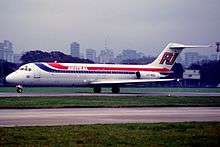Austral Líneas Aéreas Flight 2553
|
An Austral Líneas Aéreas McDonnell Douglas DC-9-32 similar to the aircraft involved in the accident | |
| Accident summary | |
|---|---|
| Date | 10 October 1997 |
| Summary | Instrument malfunction, possible pilot error |
| Site |
Nuevo Berlín, Uruguay 32°58′45″S 58°03′10″W / 32.97917°S 58.05278°WCoordinates: 32°58′45″S 58°03′10″W / 32.97917°S 58.05278°W |
| Passengers | 69 |
| Crew | 5 |
| Fatalities | 74 (all) |
| Injuries (non-fatal) | 0 |
| Survivors | 0 |
| Aircraft type | McDonnell Douglas DC-9-32 |
| Operator | Austral Líneas Aéreas |
| Registration | LV-WEG |
| Flight origin | General José de San Martín Airport, Posadas, Argentina |
| Destination | Aeroparque Jorge Newbery, Buenos Aires, Argentina |
Austral Líneas Aéreas Flight 2553, also known as Austral 2553, was a Argentinian domestic, scheduled Posadas–Buenos Aires service operated with a McDonnell Douglas DC-9-32 that crashed on the lands of Estancia Magallanes, Nuevo Berlín, 32 kilometres (20 mi) away from Fray Bentos, Uruguay, on 10 October 1997.[1][2][3] All 74 passengers and crew died upon impact.[1][4][5] The accident remains the deadliest in Uruguayan aviation history.[1]
Aircraft
The aircraft involved in the accident was a McDonnell Douglas DC-9-32, registration LV-WEG.[1][2][6] It had its maiden flight in 1969,[1] and was 28 years old at the time of the accident. It had previously operated for Iberia with registration EC-BQT, and it was transferred to Austral after the buyout of the company by the Spanish carrier.[7][8][9]
Accident
The aircraft, which left from Posadas and was due to land in Aeroparque Jorge Newbery, Buenos Aires,[6] was forced to divert towards Fray Bentos to avoid a storm. Examination of the aircraft's flight data recorder (FDR) revealed that shortly after the diversion occurred, the aircraft airspeed indicator began to fall to an alarmingly low indicated airspeed. Unbeknownst to the pilots, this was caused not directly, by a loss of power, but by ice formed inside the pitot tube, which reads the airspeed for the indicator by measuring the pressure of inflow air. The ice obstructing the pitot tube reduced the air inflow, thus giving an erroneously low indicated airspeed.
In response to what they interpreted as a loss of engine power, the pilots gradually increased power from the engines in order to maintain airspeed; seeing no improvement, they contacted the control tower in Ezeiza Airport and requested clearance to descend to a lower altitude. After receiving no response, the Captain decided to descend to a lower altitude to increase speed even with no clearance received from the Air Traffic Control. While descending from their assigned altitude of 35,000 feet and reaching 31,700 feet, the Captain identified the faulty airspeed indication and ordered the First Officer to stop descending and to reduce speed, because the readings were unreliable. However, the First Officer disregarded the Captain's commands and deployed the wings' slats to maintain their altitude and lower the plane's stall speed. Consequently, at this point the airplane was actually flying at a higher speed than normal; it was descending, which further increased airspeed to a point dangerously near to Vne, the "never exceed speed", above which structural damage to the aircraft might occur.
With the slats extended at a speed beyond their operational limits, one of them was torn from the aircraft, causing catastrophic asymmetry in the airflow over the wings. The aircraft immediately became uncontrollable and crashed.
According to an investigation by both the Argentine and Uruguayan Air Forces, the pitot tube—the primary instrument for measuring aircraft airspeeds—froze when the aircraft passed through a 15,000-metre (49,000 ft) high cumulonimbus cloud,[1] blocking the instrument and causing it to give a false reading. Compounding this problem was the failure of the alarm designed to report such a malfunction (raising serious questions about inspection irregularities by the Argentine Air Force).
During the descent, the FDR recorded an increase in the airspeed from 300 kilometres per hour (190 mph) to 800 km/h (500 mph) in three seconds, which could only signify the sudden unfreezing of the pitot tube. Specialists estimated that the aircraft crashed almost perpendicularly to the ground,[6] at a speed of 1,200 kilometres per hour (750 mph). Depending upon the source, the crater left by the crash was 6 metres (20 ft) deep and 30 m (98 ft) wide,[3] 25 feet (7.6 m) deep and 30 ft (9.1 m) wide,[10] or 25 ft (7.6 m) deep and 80 ft (24 m) wide.[1]
See also
- Air Force, Incorporated (Fuerza Aérea Sociedad Anónima), a film by former pilot Enrique Piñeyro that attempts to explain the major causes of the crash
- LAPA flight 3142
References
- 1 2 3 4 5 6 7 Accident description at the Aviation Safety Network. Retrieved on 26 May 2011.
- 1 2 Solans, Roberto (12 October 1997). "Catástrofe aérea: hubo 73 muertos" [Air disaster: 73 dead]. La Nación (in Spanish). Archived from the original on 15 March 2014.
- 1 2 "Imágenes del espanto en Nuevo Berlín" [Scary pictures at Nuevo Berlín]. La Nación (in Spanish). 12 October 1997. Archived from the original on 24 August 2016.
- ↑ "Timeline: Worst air accidents in Argentina". Buenos Aires Herald. 19 May 2011. Archived from the original on 15 March 2014.
- ↑ "El piloto no debió entrar en la tormenta" [The pilot should not have entered into the storm]. La Nación (in Spanish). 13 October 1997. Retrieved 4 May 2011.
- 1 2 3 "Storm may be to blame for Austral DC-9 crash" (pdf). Flight International: 11. 22–28 October 1997. Retrieved 29 April 2011.
- ↑ https://www.planespotters.net/airframe/McDonnell-Douglas/DC-9/47446/LV-WEG-Austral-Lineas-Aereas
- ↑ http://www.airport-data.com/aircraft/LV-WEG.html
- ↑ https://onespotter.com/aircraft/fid/321877/LV-WEG
- ↑ "75 Die in Crash of Argentine Plane in Uruguay". The New York Times. 12 October 1997. Archived from the original on 9 September 2016.
External links
- Final report (Archive) – National Civil Aviation and Aviation Infrastructure Direction (Spanish)
- "Boletín Informativo Nº 29." (Archive) Junta de Investigaciones de Accidentes de Aviación Civil (Spanish)
